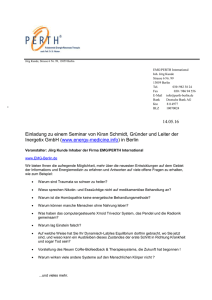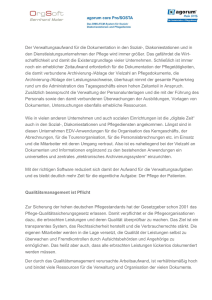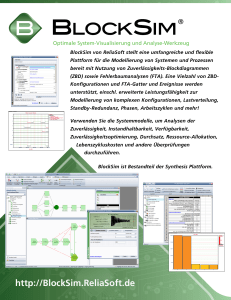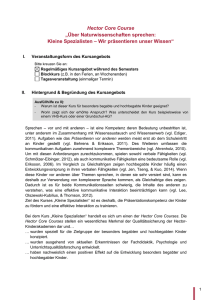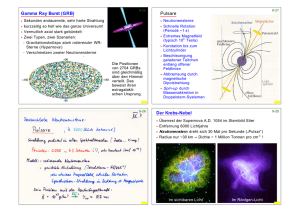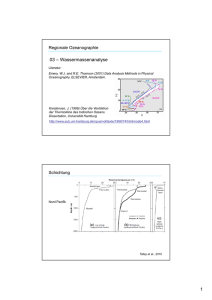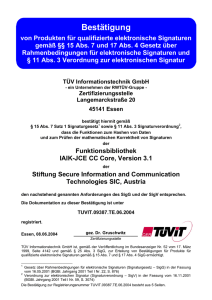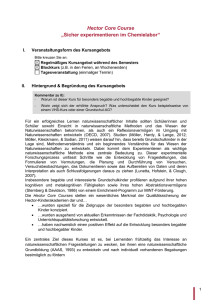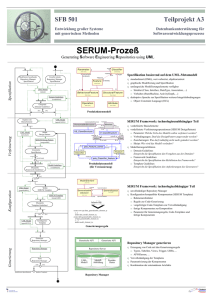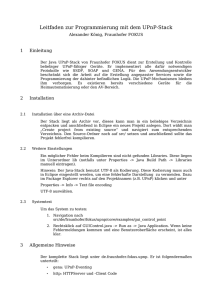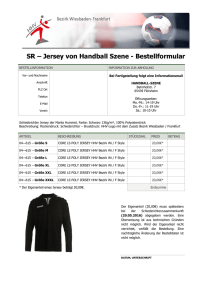Expression, productionand use for the synthesis
Werbung
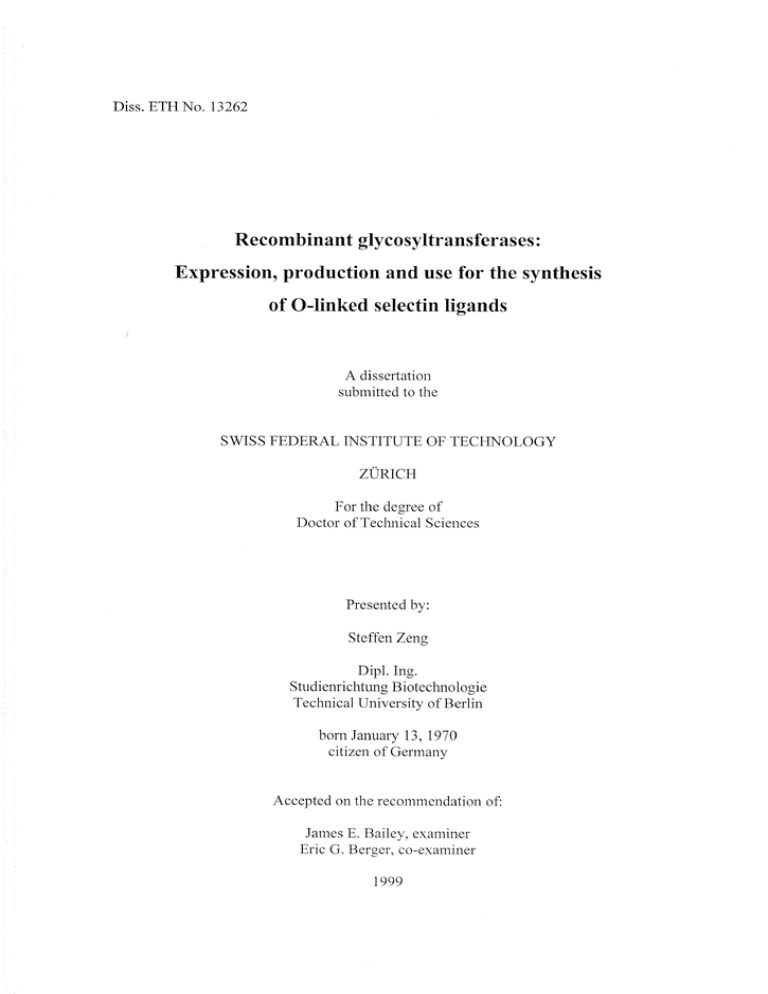
Diss. ETHNo. 13262 Recombinant glycosyltransferases: Expression, production and use for the synthesis of O-linked selectin ligands A dissertation submitted to the SWISS FEDERAL INSTITUTEOF TECHNOLOGY ZÜRICH For the degree of Doctorof Technical Sciences Presented by: Steffen Zeng Dipl. Ing. StudienrichtungBiotechnologie Technical Universityof Berlin bornJanuary 13, 1970 Citizen of Germany Accepted on the recommcndationof: James E. Bailey, examiner Eric G. Berger, co-examiner 1999 1. Zusammenfassung Bei der Entzündungsreaktion, in deren Verlauf Leukocyten den Blutstrom verlassen und in das Gewebe einwandern, wird der erste Kontakt zwischen Endothel Leukocyt über das spezifische TetrasaccharidsialylLewis Y(Neu5Ac(a2-3)Gal(ßl4)[Fuc(al-3)]GlcNAc) gebildet. Die vorliegende Dissertation beschreibt die Präparation von fünf verschiedenen Glykosyltransferasensowie deren Verwendungfür die erste voll enzymatische Synthese von O-glykosidischgebundenem sialyl Lewis X. In einem ersten Schritt wurde ß3-Galaktosyltransferase aus Ratten Leber extrahiert und für die Verlängerung des V-Acetylgalaktosamin verwendet. Die so erhaltene Galaktose ßl-3 WAcetylgalaktosamin(core 1) Struktur diente als Substrat für und die Core 2 ß6-GlcNAcT. In einem zweiten Schritt wurde eine "Chinese Hamster Ovary" etabliert, exprimiert. die Core 2 (CHO) Zelllinie ß6-V-Acetylglukosaminyltra,nsferase(ß6-GlcNAcT) Nach der Fermentation wurde das Enzym aus dem Überstand über stabil eine Affinitätschromatographieaufgereinigt. eingebaute TV-Acetylglucosamin mit der Affinitätschromatographieaus menschlicher Milch Während des dritten Schrittes wurde das ß4-Galaktosyltransferase, die über gewonnenwurde, verlängert. Mit rekombinanter Ratten und a3-Sialyltransferase, welche in aufgereinigt wurde, konnte das erhaltene Tetra- hergestellt zum Pentasaccharid umgewandelt Sf9 Zellen werden. Schliesslich wurde lösliche humane pastoris exprimiert und aus a3-Fukosyltransferase6 dem Überstand mit einer in der Hefe Pichia Affinitätschromatographie gereinigt. Mit dem so hergestellten rekombinanten Enzym wurde der letzte Syntheseschritt katalysiert. Das Endprodukt wurde über Massenspektrometrie und 'H Magnetische Kernresonanz-Spektroskopie als Core 2 basiertes sialyl Lewis X identifiziert. Der Gesamtertrag von 32 % über alle Syntheseschritte zeigt, dass die hochspezifischen Glykosyltransferasen in der Tat für die Synthese von komplexen Glykanen geeignet sind. 7 gezeigt werden, dass die Produktivität unseres Core 2 während der Kultivierung im Wirbelschichtreaktor nach In einer Nebenstudie konnte ß6-GlcNAcT CHO-Klons Erreichen einer konstanten Zelldichte kontinuierlich abnahm. Aus dem Reaktor nach 400 Stunden entnommene Zellen erreichten im Produktivität. Die Analyse der Zellzyklusverteilung 24 Stunden transfiziertenZellen im Satzbetrieb wieder maximale ergab, dass die konventionellnach synchronisierten Zustand S- als in der G0/G1 -Phase bildeten. Eine 5 mal mehr Produkt in der Überprüfungder Herstellungsprozedur ergab, diesem Zeitpunkt der grösste Anteil an Zellen in der S-Phase befindet. Transformation in S-Phase führte demnach zu hoher Produktivität in S-Phase. Durch dass sich zu Transformationszeitpunkteswurden dann Zellen transfiziert, die sich zum überwiegendenTeil in der G0/G1-Phase befanden. Für zwei unabhängigeReporter Verschieben des Proteine konnte durch diese Modifikation ein verändertes Expressionsverhaltenerreicht werden. Transformation in G0/G1-Phase führte demnach signifikant erhöhter Produktion in GO/G'l-Phase. Diese Ergebnisse weisen darau.fl.iin, dass für eine optimale Produktion das Zusammenspiel von Transformation und Expression mit Hinblick auf das zu wählende Kultivierungssystem nicht vernachlässigt werden darf. zu 2. Summary In the inflammatory process, during which leukocytes leave the blood stream and migrate into the tissue, the initial contact between the endotheliaand the leukocyte is specific tetrasaccharide sialyl Lewis X (Neu.5Ac(a2-3)Gal(ßl4)[Fuc(al-3)]GlcNAc). This thesis describes the preparation of five different glycosyltransferases as well as their use for the first füll enzymic synthesis of the Oglycosidically linked sialyl Lewis X. In a first step ß3-galactosyltransferase was extracted from rat liver and used for the elongation of Wacetylgalactosamine. The product galactose ßl-3 Nacetylgalactosamine(core 1) structure could afterwardsbe branchedwith the Core 2 ß6established via the GlcNAcT. second step a Chinese Hamster Ovary (CHO) cell line was established that expressed Core 2 ß6-/V-acetylglucosaminyltransferase (ß6-GlcNAcT). After In stably a fermentationthe enzyme was purified from the supernatantby affmity chromatography. During the third step the incorporatedV-acetylglucosamine was elongated with ß4-galactosyltransferase, obtained through affmitychromatographyfrom human milk. Using recombinant rat cx3-sialyltransferase, which was produced with Sf9 cells and purified, the obtained tetrasaccharide could be converted to the pentasaccharide. Finally soluble human a3-fucosyltransferase 6 was expressed in the yeast Pichia pastoris and purified from the supernatant by affmity chromatography. This recombinant enzyme catalyzed the last step of the synthesis. The final product was identified by Mass Spectrometry and 'H Nuclear Magnetic Resonance as Core 2 based sialyl LewisX. The overall yield of 32 % obtained for the whole synthesis demonstrates that the highly specific glycosyltransferases are suited for the synthesis of complex glycans. As a side project we showed that the productivity of our Core 2 ß6-GlcNAcT CFIO clone continuously decreased during eultivation in the fluidized bed reactor after a steady state cell concentrationwas reached. Cells taken from the reactor after 400 hours reached again maximum productivity in a batch fermentation. The analysis of the cell cycle distribution revealed that the cells conventionally transfected after 24 hours formed 5 times more product in S- than in GO/Gl-phase under synchronized conditions. Evaluating the transfection procedure revealedthat at this time point the majority of the cells are in the S-phase. Transfection in S-phase thus led to high productivity in Sphase. Thereafter, cells were transfected, when the majority of the cells were in G0/G1phase, by shifting the time point of transfection. Through this modification a changed expression pattern could be achieved for two indcpendent reporter proteins. Transfection in GO/G1 -phase, therefore, led to significantly higher production in G0/G1 -phase. These results indicate that for an optimal production the interplay of transfection and expression with regard to the choice of the cultivation system should not be neglected.
